
In the past many variations existed, including negative zero (which is still in use today, but not as much as a 'zero' zero) or even 3-stated machines. In most computers/microchips the standard voltage for 1 is 5 volts and the standard voltage for 0 is 0 volts. Usually this representation is implemented by voltage presence. For instance – no electricity means 0 and the presence of electricity means 1. This is because it is easy to make a stable representation of two different states, using electricity. This is the natural “language” for our computers. The binary number system (or base 2 numeral system) has two digits in its alphabet – 0 and 1. Increase the power by one with each position to the left. WeĪlways start from a power of 0, as the right-most position and The same rule applies to any other positional number system. Work with powers of 10, because 10 is the base of the system that we Remember, each number to the power of 0 is equal to 1. 3 times 10 to the power of 1 4 = 4 *10 0 or. 2 times ten to the power of 2 30 = 3 * 10 1 or. You already know how this works, because you work with numbers all the time. To represent a given number we need to break it down to a sum of exact powers of the base of that notation. Value representationĪll positional systems that we use, represent the numbers in the same manner. In particular the most useful once have a base that is an exact power of 2 – binary(base 2) and hexadecimal(base 16 = 2 to the power of 4). In programming, we are interested in positional systems. The number “XXX” is equal to their sum 30. Here is an example: X : the symbol 'X' means 10 XXX : each symbol has the value of 10. An example for non positional notation is the Roman numeric system.

In non-positional numeral systems, the value of the digits does not depend on their position.

One example: 10 – the digit 1 has a value of ten 1000 – the same digit 1, has a value of a thousand, because it is in a different position. In positional notations the value of a digit depends on its position. Positional and non positional number systems 123 10, 110010 2, 1F4 16 If the base is not provided, the default is that the number is in decimal. When a number is written, its base should be written after the number in subscript. More importantly, it plays a roleįor the representation of the numbers in the positional notations. ForĮxample the decimal system uses 10 digits.īase serves not only for naming. Their base – binary, octal, decimal, hexadecimal. These symbols (digits) are oftenĬalled alphabet of that system. Base of a number system (or notation) is the number of symbols that


 0 kommentar(er)
0 kommentar(er)
